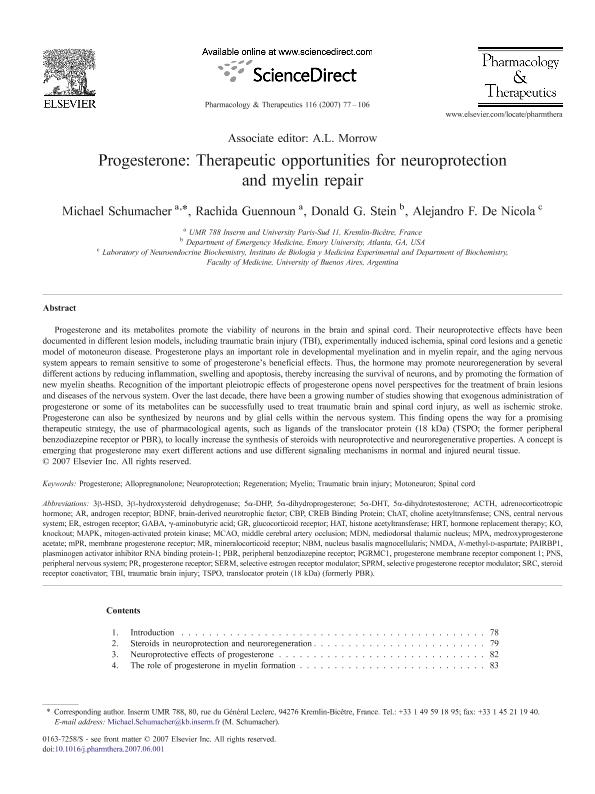Mostrar el registro sencillo del ítem
dc.contributor.author
Schumacher, Michael
dc.contributor.author
Guennoun, Rachida
dc.contributor.author
Stein, Donald G.
dc.contributor.author
de Nicola, Alejandro Federico

dc.date.available
2017-10-09T19:31:35Z
dc.date.issued
2007
dc.identifier.citation
Schumacher, Michael; Guennoun, Rachida; Stein, Donald G.; de Nicola, Alejandro Federico; Progesterone: therapeutic opportunities for neuroprotection and myelin repair; Elsevier; Pharmacology & Therapeutics; 116; 1; -1-2007; 77-106
dc.identifier.issn
0163-7258
dc.identifier.uri
http://hdl.handle.net/11336/26255
dc.description.abstract
Progesterone and its metabolites promote the viability of neurons in the brain and spinal cord. Their neuroprotective effects have been documented in different lesion models, including traumatic brain injury (TBI), experimentally induced ischemia, spinal cord lesions and a genetic model of motoneuron disease. Progesterone plays an important role in developmental myelination and in myelin repair, and the aging nervous system appears to remain sensitive to some of progesterone's beneficial effects. Thus, the hormone may promote neuroregeneration by several different actions by reducing inflammation, swelling and apoptosis, thereby increasing the survival of neurons, and by promoting the formation of new myelin sheaths. Recognition of the important pleiotropic effects of progesterone opens novel perspectives for the treatment of brain lesions and diseases of the nervous system. Over the last decade, there have been a growing number of studies showing that exogenous administration of progesterone or some of its metabolites can be successfully used to treat traumatic brain and spinal cord injury, as well as ischemic stroke. Progesterone can also be synthesized by neurons and by glial cells within the nervous system. This finding opens the way for a promising therapeutic strategy, the use of pharmacological agents, such as ligands of the translocator protein (18 kDa) (TSPO; the former peripheral benzodiazepine receptor or PBR), to locally increase the synthesis of steroids with neuroprotective and neuroregenerative properties. A concept is emerging that progesterone may exert different actions and use different signaling mechanisms in normal and injured neural tissue.
dc.format
application/pdf
dc.language.iso
eng
dc.publisher
Elsevier

dc.rights
info:eu-repo/semantics/openAccess
dc.rights.uri
https://creativecommons.org/licenses/by-nc-nd/2.5/ar/
dc.subject
Central Nervous System Diseases
dc.subject
Nerve Regeneration
dc.subject
Neuroprotective Agents
dc.subject
Progesterone
dc.subject.classification
Neurociencias

dc.subject.classification
Medicina Básica

dc.subject.classification
CIENCIAS MÉDICAS Y DE LA SALUD

dc.title
Progesterone: therapeutic opportunities for neuroprotection and myelin repair
dc.type
info:eu-repo/semantics/article
dc.type
info:ar-repo/semantics/artículo
dc.type
info:eu-repo/semantics/publishedVersion
dc.date.updated
2017-10-06T18:01:10Z
dc.identifier.eissn
1879-016X
dc.journal.volume
116
dc.journal.number
1
dc.journal.pagination
77-106
dc.journal.pais
Países Bajos

dc.journal.ciudad
Amsterdam
dc.description.fil
Fil: Schumacher, Michael. Inserm; Francia. Universite Paris Sud; Francia
dc.description.fil
Fil: Guennoun, Rachida. Inserm; Francia. Universite Paris Sud; Francia
dc.description.fil
Fil: Stein, Donald G.. University of Emory; Estados Unidos
dc.description.fil
Fil: de Nicola, Alejandro Federico. Universidad de Buenos Aires. Facultad de Medicina. Departamento de Bioquímica Humana; Argentina. Consejo Nacional de Investigaciones Científicas y Técnicas. Instituto de Biología y Medicina Experimental. Fundación de Instituto de Biología y Medicina Experimental. Instituto de Biología y Medicina Experimental; Argentina
dc.journal.title
Pharmacology & Therapeutics

dc.relation.alternativeid
info:eu-repo/semantics/altIdentifier/url/http://www.sciencedirect.com/science/article/pii/S0163725807001106
dc.relation.alternativeid
info:eu-repo/semantics/altIdentifier/doi/http://dx.doi.org/10.1016/j.pharmthera.2007.06.001
dc.relation.alternativeid
info:eu-repo/semantics/altIdentifier/pmid/17659348
Archivos asociados
